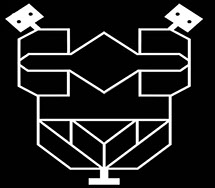Clamps
Clutches
Crimpers
DaCMs
Direction
changers
Grippers
Indicators
Path
generators
Shape
changers
Suspensions
CA CMs
Bistable
CMs
Holding an object tightly without sustained external force is a characteristic of a clamping compliant mechanism. A force is applied to enlarge a small opening to insert an object and then the force is released. The elastic nature of compliant mechanisms tries to close the gap back to the original size but it cannot as there is an object. So, a clamping force is sustained on the object. Many snap-fits assemblies use this principle. Some have clever designs to release the clamp.
A clutch is a variant of the general gripper. It also resembles a clamp. As in an automotive clutch, a compliant clutch can have multiple usable states. A centrifugal clutch is an interesting application to connect two parts only when the speed of rotation reaches a certain threshold. One-way clutches are also popular to allow free motion in one direction and transmit force or torque in another direction.
A crimper, an extension of a gripper, is a classical compliant mechanism. A compliant crimping mechanism that had an intriguing mechanical advantage was one of the first compliant mechanisms that were systematically investigated and designed by Prof. Ashok Midha. Usually, a crimper should apply increasing force on the object as the actuated force gradually increases. The inherent "loss" of energy in elastically deforming the compliant mechanism poses challenges in crimper design in view of mechanical advantage and mechanical efficiency.
DaCM (Displacement-amplifying Compliant Mechanism)
As the name implies, a Displacement-amplifying Compliant Mechanism (DaCM), gives more displacement at the output as compared to that at the input. It is essentially a compliant lever. Unlike rigid-body levers, DaCM can be designed to be compact and non-intuitive. For example, they can be designed to deform inwards within their original footprint and yet have significant amplification of the displacement. They are used in sensors and actuators, especially in miniature applications as in Microelectromechanical Systems (MEMS). Macro-scale applications are not unheard of.
Direction-changing compliant mechanism
In most compliant mechanisms, input and output motions are not in the same direction. In that sense, direction-changing CM is a general category. Sometimes, the primary intent itself is to change the direction of movement. Actuation in a straight line giving rise to rotation (and vice versa) is an example. Input and output being in opposite direction (as in an inverter) is another example.
7
303x198.jpg?crc=184886405)
8
239x237.jpg?crc=3977917165)
48
291x222.jpg?crc=508890448)
Compliant grippers are most popular. Their primary purpose is to grasp an object but they are also used to apply force on the object to measure its stiffness. Clamps and clutches are variants of the gripper concept. A challenge in gripper design is to achieve parallel motion of its jaws. The mechanical advantage and mechanical efficiency also need to be considered carefully in designing grippers.
Compliant indicators predate the field of compliant mechanisms. A Bourdon Pressure Gauge is a compliant mechanism wherein the increasing pressure in the bent tube of elliptical cross-section causes a pointer to move linearly along a circular arc. A mechanical weighing machine is another example of it. Unlike the rigid-body mechanisms that use an additional spring, an indicator CM uses inherent elastic deformation as a spring. An indicator CM is a combination of a DacM and direction-changing CM. They are used in mechanical sensor applications.
When large forces are applied, the output point of a compliant mechanism traces a curved path rather than a straight line. In fact, large output along a straight line is quite hard to achieve in a compliant mechanism. Often, symmetry is used to achieve straight-line motion. Likewise, achieving a specific curved path perfectly is also a challenge. Analysis of compliant path generators requires geometrically nonlinear behavior to be considered.
In a shape-changing compliant mechanism, we are interested in not a single output point but a large portion of the CM or an array of points. It is similar to "motion generation" task in rigid-body mechanisms. It is arguably the toughest CM to design. Changing the shape of an aircraft wing is the most notable application.
Compliant suspensions are more like joints that give desired relative mobility between two objects, primarily between a moving object and a reference (often static) object. A compliant suspension mechanism can be designed to have high stiffness in one or more directions and very low stiffness in others. They can also de-couple the motion in different directions. Their main applications are in Microelectromechanical Systems (MEMS) and precision instruments.
29
30
33
34
35
225x121.png?crc=391921854)
225x203.jpg?crc=4175078473)
36
225x130.jpg?crc=4273698823)
225x129.jpg?crc=232843055)
319x121.jpg?crc=4243309413)
225x175.png?crc=4156168996)
38
225x204.jpg?crc=256155269)
37
39
225x175.png?crc=3796944154)
225x206.jpg?crc=3982415854)
76
77
Contact-aided compliant mechanisms
Parts of compliant mechanisms do not touch one another as the mechanism deforms. If they do, the sudden change of boundary condition changes the behavior of the compliant mechanism. For example, the output can suddenly change or the force-displacement profile can have a sudden change. This contact-aided nonlinearity is a hallmark of such CMS. The contact can be self contact or a contact with another object such as the fixed reference. While giving interesting motion and force transmission possibilities, CCMs suffer from friction and wear, unlike other compliant mechanisms. Thus, they defy an inherent trait of a compliant mechanism in not having parts that rub against each other.
Exploiting the inherent geometric nonlinearity in elastic continua, bistable compliant mechanisms possess two force-free stable states. That is, they exist in two stable equilibrium states in the absence of external forces. One state, as-fabricated, could be free from stress; and another with stress. More common is the case where both states have stresses, as in a buckled beam. Bistable CMs have applications primarily in switches and valves but could be used creatively in many other applications (e.g., static balancing). Snap-through CMs are precursors to bistable CMs. Both have a negative-slope region in their force-displacement characteristics. This is an appealing feature for ingenious mechanical design of CMs.


184x236.jpg?crc=4061182456)
165x235.jpg?crc=215636665)
221x241.jpg?crc=454123954)
203x236.jpg?crc=482942836)
160x245.png?crc=17651060)
273x272.jpg?crc=4289684648)
273x250.jpg?crc=178702582)
155x187.jpg?crc=467057693)
230x178.jpg?crc=491977596)
218x174.jpg?crc=167177540)
134x242.jpg?crc=3800158158)
196x242.jpg?crc=3862372676)
208x223.jpg?crc=118136378)
210x146.jpg?crc=18431942)
208x125.jpg?crc=491269949)
242x134.jpg?crc=4089776920)
231x124.jpg?crc=475896943)
177x221.jpg?crc=92455245)
188x153.jpg?crc=4097532022)
.jpg?crc=3901924538)
.jpg?crc=4050084939)
.jpg?crc=170558199)
165x168.jpg?crc=104280976)
158x183.jpg?crc=3947716506)
150x193.jpg?crc=60475077)
167x184.jpg?crc=58751388)
159x162.jpg?crc=3871340955)
167x156.jpg?crc=4102334225)
139x159.jpg?crc=3993048515)
.jpg?crc=3939105102)
150x129.jpg?crc=3882926810)
150x112.jpg?crc=505798686)
-crop-u73718.jpg?crc=302615548)
150x155.jpg?crc=410799673)
133x143.jpg?crc=162302455)
150x110.jpg?crc=211491618)
150x131.jpg?crc=4125463917)
168x127.jpg?crc=322088315)
197x123.jpg?crc=4028084086)
198x121.jpg?crc=4285270552)
150x273.jpg?crc=159405399)
468x185.jpg?crc=347798841)
414x185.jpg?crc=4119696887)
.jpg?crc=4122295685)
288x257.jpg?crc=278342618)
330x202.jpg?crc=356681330)
-crop-u74581.jpg?crc=200253773)
230x91.jpg?crc=3960465553)
225x174.jpg?crc=153824073)
226x181.jpg?crc=3834868655)
104x188.jpg?crc=175927820)
153x189.jpg?crc=3928704838)
225x147.jpg?crc=4020796952)
189x188.jpg?crc=129569588)
225x156.jpg?crc=3921097592)
185x188.jpg?crc=3885837373)
147x188.jpg?crc=257673299)
162x188.jpg?crc=435033174)
225x135.jpg?crc=412438703)
226x125.jpg?crc=309989693)
146x188.jpg?crc=4891169)
171x188.jpg?crc=413912302)

226x101.jpg?crc=3792075567)
185x189.jpg?crc=69677003)
201x188.jpg?crc=460514558)
164x188.jpg?crc=3854364512)
219x188.jpg?crc=201800834)
176x188.jpg?crc=168707597)
132x188.jpg?crc=346879656)
225x138.jpg?crc=370775259)
226x121.jpg?crc=175922297)
226x131.jpg?crc=421347184)
173x188.jpg?crc=331965947)
151x188.jpg?crc=3910993805)
226x86.jpg?crc=198847531)
205x188.jpg?crc=331204133)
209x188.jpg?crc=4290062443)
208x188.jpg?crc=4010024072)
182x188.jpg?crc=3913829720)
225x168.jpg?crc=4278864048)
175x188.jpg?crc=4211917680)
177x188.jpg?crc=3878307594)
226x166.jpg?crc=3921333808)
225x141.jpg?crc=3851201677)
225x137.jpg?crc=437495549)
215x188.jpg?crc=3957389266)
226x172.jpg?crc=452527313)
161x188.jpg?crc=3861325193)
211x188.jpg?crc=4239480218)
189x188.jpg?crc=8186821)
206x188.jpg?crc=3782787531)
.jpg?crc=162531667)
123x188.png?crc=3956545728)
103x188.jpg?crc=4017931356)
226x184.jpg?crc=4161320841)
225x170.jpg?crc=4216055321)

-crop-u55474.jpg?crc=251888790)
.jpg?crc=128400408)
